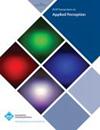Eye Height Manipulations: A Possible Solution to Reduce Underestimation of Egocentric Distances in Head-Mounted Displays
IF 1.9
4区 计算机科学
Q3 COMPUTER SCIENCE, SOFTWARE ENGINEERING
引用次数: 33
Abstract
Virtual reality technology can be considered a multipurpose tool for diverse applications in various domains, for example, training, prototyping, design, entertainment, and research investigating human perception. However, for many of these applications, it is necessary that the designed and computer-generated virtual environments are perceived as a replica of the real world. Many research studies have shown that this is not necessarily the case. Specifically, egocentric distances are underestimated compared to real-world estimates regardless of whether the virtual environment is displayed in a head-mounted display or on an immersive large-screen display. While the main reason for this observed distance underestimation is still unknown, we investigate a potential approach to reduce or even eliminate this distance underestimation. Building up on the angle of declination below the horizon relationship for perceiving egocentric distances, we describe how eye height manipulations in virtual reality should affect perceived distances. In addition, we describe how this relationship could be exploited to reduce distance underestimation for individual users. In a first experiment, we investigate the influence of a manipulated eye height on an action-based measure of egocentric distance perception. We found that eye height manipulations have similar predictable effects on an action-based measure of egocentric distance as we previously observed for a cognitive measure. This might make this approach more useful than other proposed solutions across different scenarios in various domains, for example, for collaborative tasks. In three additional experiments, we investigate the influence of an individualized manipulation of eye height to reduce distance underestimation in a sparse-cue and a rich-cue environment. In these experiments, we demonstrate that a simple eye height manipulation can be used to selectively alter perceived distances on an individual basis, which could be helpful to enable every user to have an experience close to what was intended by the content designer.眼高度操纵:减少头戴式显示器中自我中心距离低估的可能解决方案
虚拟现实技术可以被认为是一种多用途的工具,适用于各种领域,例如培训、原型制作、设计、娱乐和调查人类感知的研究。然而,对于许多这样的应用程序,有必要将设计和计算机生成的虚拟环境视为真实世界的复制品。许多研究表明,情况并非如此。具体来说,无论虚拟环境是显示在头戴式显示器还是沉浸式大屏幕显示器上,与现实世界的估计相比,自我中心距离都被低估了。虽然这种距离低估的主要原因仍然未知,但我们研究了一种潜在的方法来减少甚至消除这种距离低估。建立在地平线以下的倾角关系来感知以自我为中心的距离,我们描述了虚拟现实中的眼睛高度操作应该如何影响感知距离。此外,我们还描述了如何利用这种关系来减少对单个用户的距离低估。在第一个实验中,我们研究了操纵眼睛高度对基于行动的自我中心距离感知测量的影响。我们发现,眼高操纵对基于行动的自我中心距离测量有类似的可预测影响,就像我们之前在认知测量中观察到的那样。这可能会使此方法比在不同领域(例如协作任务)的不同场景中提出的其他解决方案更有用。在另外三个实验中,我们研究了在稀疏线索和丰富线索环境下,人眼高度的个性化操作对减少距离低估的影响。在这些实验中,我们证明了一个简单的眼睛高度操作可以用来选择性地改变个人的感知距离,这可能有助于让每个用户都有接近内容设计师意图的体验。
本文章由计算机程序翻译,如有差异,请以英文原文为准。
求助全文
约1分钟内获得全文
求助全文
来源期刊

ACM Transactions on Applied Perception
工程技术-计算机:软件工程
CiteScore
3.70
自引率
0.00%
发文量
22
审稿时长
12 months
期刊介绍:
ACM Transactions on Applied Perception (TAP) aims to strengthen the synergy between computer science and psychology/perception by publishing top quality papers that help to unify research in these fields.
The journal publishes inter-disciplinary research of significant and lasting value in any topic area that spans both Computer Science and Perceptual Psychology. All papers must incorporate both perceptual and computer science components.
 求助内容:
求助内容: 应助结果提醒方式:
应助结果提醒方式:


